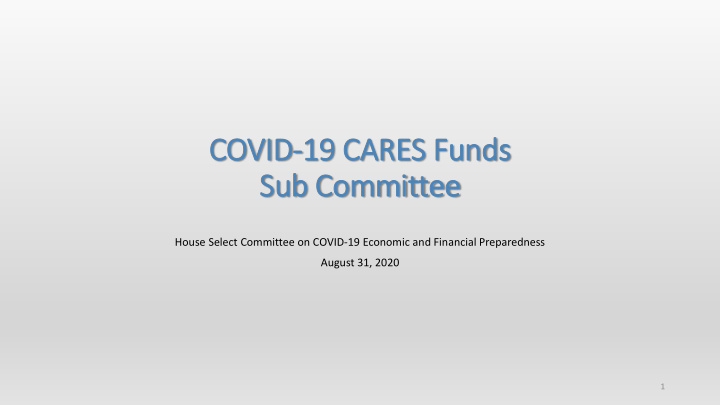



COV OVID-19 C 19 CARES F Fund nds Sub C Commi mmittee House Select Committee on COVID-19 Economic and Financial Preparedness August 31, 2020 1
PURPOSE AND SCOPE PROVIDE OVERSIGHT THE APPROPRIATED OVER CARES FUNDS FUNDS ARE IN ADDITION APPROPRIATED TO THE TO THE $1.25B LUMPSUM STATE APPROPRIATED TO THE STATE (+15 line items ~$125M) TO ENSURE THAT CARES WE WILL INCLUDE EFFORTS OF FUNDS ARE TIMELY AND OTHER GOV’T OFFICIALS EFFECTIVELY SPENT IN HAWAI ʻ I 2
TASKS 1. IDENTIFY APPROPRIATED 2. IDENTIFY AGENCIES 3. IDENTIFY WHETHER FUNDS & PURPOSE THAT WILL RECEIVE FUNDS CAN BE DISBURSED APPROPRIATIONS THROUGH GRANTS 4. MONITOR STATUS OF 5. ORGANIZE AND THE EXPENDITURES OF COMMUNICATE THIS SUCH FUNDS INFORMATION 3
PROCESS & PRODUCTS HISTORICAL ACCOUNTING/INFO IDENTIFY CURRENT RAISE FUTURE OPPORTUNITIES CHALLENGES/SOLUTIONS • Curated List of Upcoming COVID, • Primary Data Source • For CARES (SB126) plus select other non-COVID competitive grants to • All Federal Funds $9B funds share with: • Monthly reports of • Work with State & County officials to receipts/expenditures by: identify challenges early: • Government • Institutions • Category • Program infrastructure, capacity • Nonprofit • Program (people, tech) • Businesses • Recipient, sub recipient • Overlap with other programs (or • Federal Dept State vs County) STATUS: • Deadline • Clarity of federal rules/ compliance • Designed and distributed lists to HCF, (e.g., eligibility, etc) HANO STATUS: • Brainstorming ways to prepare • Reconciliation complete STATUS: nonprofit community for grant • State & National reports identified • Collaborating with government cycles, requirements • Report design is live officials as they build process to • CARES funds report is a subset engage with program owners • Beginning scan of complementary program types, beneficiaries 4
Today’s Update • Latest Drawdown and Expenditure Report, reconciled with State Federal Awards Management as of 7/31/2020 • Data Visualization as of 7/31/2020 • Synopsis and Concerns. • See Civil Beat Essay: "We-need-to-spend-half-a-billion-dollars-in-123-days- heres-how-to-do-it" submitted by Jill Tokuda on 8/29/2020. 5
DATA VISUALIZATION 6
Synopsis – Drill down, isolate concern Award Amount Expenditure Total $9,026,487,509 $6,896,994,191 76.41% SBA, IRS, UI, SNAP, etc $6,772,123,659 $6,756,124,124 99.76% (>75% spent) $2,254,363,850 $140,870,068 6.25% non-CRF COVID (avail 4-5/20) $1,004,363,850 $61,685,729 6.14% CRF (approved by Gov 7/30) $1,250,000,000 $79,184,339 6.33% Non-CRF COVID was received and ready for spending primarily in April/May of 2020 thru various dates. CRF is within the scope of this committee and was received in May 2020 and approved by Governor end of July, to be spent by 12/31/2020. 7
Q: Does the pace & type of our COVID resource flows reflect our Stabilization on & Reopening plan & priorities? CDC guidelines? IF Stabilization relies on: • aggressive public health protocols, with a focus on vulnerable communities, spread vectors • continuous learning for our kids, youth AND reopening of schools AS REQUIRED FOR Reopening the economy, THEN • Why are significant related resources (non CRF COVID funds) still unspent? (examples on next slide) • Why are proper use and distribution of PPE, testing & contact tracing for CDC Priority 1 groups still unresolved (essential workforce & congregate settings - incarcerated, houseless, public housing, Micronesians, educational institutions, front line who serve vulnerable) • Why don’t we have data related to breakouts so that related actions on what to close or open can be strategic? Is this capability (human/tech/data science) resourced? • How do we educate and communicate with our citizenry so that they know what to do? Is this resourced? 8
Pace of certain Non Non C CRF COVI VID (out of committee scope, but relevant) PROGRAM AWARD EXPENDITURE ENCUMBERED CDC Epidemiology & Lab Capacity 60,592, 455 137,218 406,857 CDC Rapid Funding 6,317,500 981,494 1,026,917 Education (K-12, Higher ed) 96,990,529 10,423,218 14,985,801 Emergency Solutions Grants (DHS, City & County) 34,835,055 ? ? Childcare & Development Block Grant 11,990,147 139,370 0 Headstart 2,530,000 0 0 Public Housing Operating Funds 4,128,858 413,411 0 Community Health Centers 14,680,713 0 0 9
How do we learn from Non Non C CRF COVI VID funds as CRF F ramps up (in committee scope) FACTS/CURRENT SITUATION: • DIRECT FLOW: The line items that were pushed out rapidly were primarily through SBA/banks/credit unions, direct to businesses & individuals. • CAPACITY: CRF passes through certain State Department agencies that are already stretched with expanded scope due to COVID. • COMPETING OBJECTIVES: CRF relies on government agencies to sub-award to private sector nonprofits who have competing objectives (protect against impropriety vs. expediency/ease for beneficiaries in need) • Contract terms are challenging to finalize, eating into time for execution. • UNALLOCATED FUNDS: $371m that was line-item vetoed is not allocated, tied up until 9/15/2020. 10
CRF F (in committee scope) QUESTIONS: • How do we make sure that what we learned from non CRF COVID will inform what we do with CRF especially with such significant needs (July cliff) and short deadlines to spend? • Are we leaning on and protecting private providers with understanding of ‘recipients-in- need’ and strong demonstrated capabilities? • How do we insert entrepreneurial mindsets to address competing objectives of government and private intermediaries utilizing new methods, data/technology? • How does the allocation of CRF align with or go against non CRF COVID to address our most urgent needs (data informed infection sources/hot-spots, education/health equity issues, etc.)? • How can/will the unallocated $371M be allocated in a way to address needs or build new capabilities, have flexibility? See Jill’s article for ideas. 11
appendix 12
Status of ‘CR CRF’ as of 7/31 Prepared by State of Hawaii Federal Awards Mgmt. Excludes City and County of Honolulu ($387M) and line-item veto ($371M) 13
Recommend
More recommend